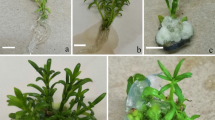Abstract
ROOT buds are known in several species of Ophioglossum, and are the common means of propagation1–3. In an experimental investigation of bud formation in Ophioglossum vulgatum, root buds have been induced in both entire and decapitated isolated roots. While some buds may be formed from a segment of the root apical meristem, as described by Rostowzew2, those which occur at random along the root develop from parenchyma cells of the middle cortex and are endogenous. Endogenous buds have also been induced in the pith parenchyma of shoots from which the apex had been excised (Figs. 1–3). In the formation of these endogenous root and shoot buds the following developments have been observed : the inception of a growth centre in a group of deeply seated parenchyma cells ; the rapid division of one or more of these cells to form a spherical or ellipsoidal meristematic cell mass (Fig. 2) ; the formation of an upwardly directed nascent shoot apex by the elongation and longitudinal division of a group of cells within this mass (Fig. 3) ; the lysis and distension of the adjacent cells above, so that the upper surface of the nascent apical meristem becomes freely exposed to the small air space thus formed ; the early formation of a rapidly growing first leaf and first root (Fig. 1) ; a concentric organization of the meristematic and parenchyma cells surrounding the apex so that they constitute a protective sheath which resembles a normal stipular sheath ; and the basi-petal development of an incipient vascular strand by the Jongitudinal division of the parenchyma cells situated below the bud (Fig. 1), phloem and xylem being eventually differentiated in this strand. Root buds are not formed by the transformation of incipient lateral roots—these, in fact, do not occur in O. vulgatum—and they bear no obligate relationship to the orientation of the root stele. The subsequent developments leading to the formation of a young plant, with a shoot-apex and several leaves and roots, are as in the normal development.
This is a preview of subscription content, access via your institution
Access options
Subscribe to this journal
Receive 51 print issues and online access
$199.00 per year
only $3.90 per issue
Buy this article
- Purchase on Springer Link
- Instant access to full article PDF
Prices may be subject to local taxes which are calculated during checkout
Similar content being viewed by others
References
Stenzel, K. G., Nova Acta Acad. Caes. Leopold, Car. Nat. Cur., 26, Pt. II, 769 (1857).
Rostowzew, S., L. Over. Kong. Danske Vidensk. Selsk., 54 (1891).
Goebel, K., Biol. Centralb., 22, 493 (1902).
Author information
Authors and Affiliations
Rights and permissions
About this article
Cite this article
WARDLAW, C. Endogenous Buds in Ophioglossum vulgatum L.. Nature 171, 88–89 (1953). https://doi.org/10.1038/171088a0
Issue Date:
DOI: https://doi.org/10.1038/171088a0
This article is cited by
-
Buds on the Roots of the Rosebay Willow-herb (Fireweed)
Nature (1954)
Comments
By submitting a comment you agree to abide by our Terms and Community Guidelines. If you find something abusive or that does not comply with our terms or guidelines please flag it as inappropriate.



